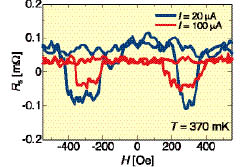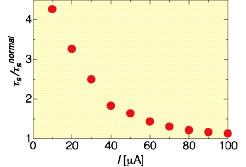Spin Injection into a Superconducting Niobium
Otani Group
Spintronics is a spin counterpart of electronics and its potentiality for future applications as well as for novel physics has boosted a number of researches in recent years. Among diverse materials, superconductors are promising for their distinct properties of spin transport; because of a superconducting energy gap, spins are mediated by quasiparticles and it is theoretically predicted that the spin relaxation time (τs) is enhanced owing to the reduced group velocity of quasiparticles. However, previous experimental studies are not conclusive due to the problems of device structures. Thus, for both basic physics and applications, it is highly desirable to estimate τs in superconductors correctly without spurious effects. In this work [1], we aimed at injecting a pure spin current into superconductors with a large spin-orbit (SO) interaction and estimating τs appropriately. Through the use of such superconductors, we can expect more complex phenomena for further studies where superconductivity, magnetism and SO interaction are closely coupled.

Fig. 1. NLSV signals Rs measured at 370 mK (< TC) with two different currents I = 20 μA (red) and 100 μA (blue).

Fig. 2. The relation between τs and I. τs is normalized by that in the normal state (τsnormal = 2.3 × 10−13 s). As I decreases, τs dramatically increases.
We fabricated a typical lateral spin valve structure with a superconductor Nb, consisting of two ferromagnetic Permalloy (Ni81Fe19; Py) wires bridged by a nonmagnetic Cu wire and a Nb wire inserted below the Cu bridge in between the two Py wires. By flowing a charge current (I) from one of the Py wires to the Cu, a pure spin current is generated in the Cu bridge and partly absorbed into the Nb due to its large SO interaction. The pure spin current can be detected by the other Py wire, and the detected nonlocal spin valve (NLSV) signal is reduced when the spin absorption occurs. In our study we performed spin absorption measurements both above and below the critical temperature of Nb (TC = 5.5 K).
In Fig. 1, we show a result of the spin absorption measurements taken at 370 mK, much lower than TC. The NLSV signal shown here is normalized by I. Above TC, it is independent of I (not shown here), as expected for normal metals. Far below TC, on the other hand, the NLSV signal obviously increases as I decreases, indicating the suppression of the spin absorption at the Nb wire. In order to evaluate the amount of the pure spin current absorbed from Cu into Nb, we calculated the density of states of the superconducting Nb using the Usadel equation where the superconducting proximity effect between Cu and Nb is taken into account. In the Usadel equation, τs of the superconducting Nb is treated as a free parameter. With this parameter, we can reproduce the NLSV signal for each I, and simultaneously obtain τs. The obtained data are shown in Fig. 2. τs is clearly enhanced with decreasing I. To know the relation between I and temperature, we also measured the interface resistance between Cu and Nb as functions of I and temperature, and found that the effective temperature (T) at the interface is increased by I. These results clearly demonstrate the enhancement of τs in a superconductor with decreasing T consistent with the theoretical prediction [2].
References
- [1] T. Wakamura, N. Hasegawa, K. Ohnishi, Y. Niimi, and Y. Otani, Phys. Rev. Lett. 112, 036602 (2014).
- [2] T. Yamashita, S. Takahashi, H. Imamura, and S. Maekawa, Phys. Rev. B 65, 172509 (2002).
